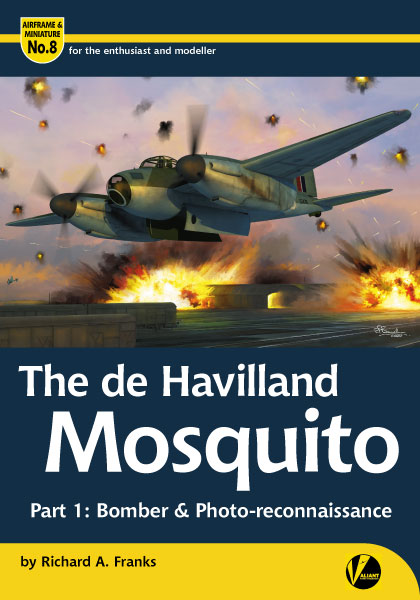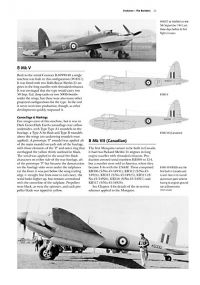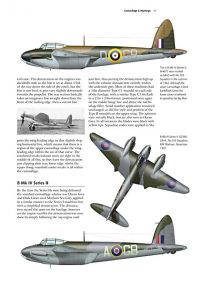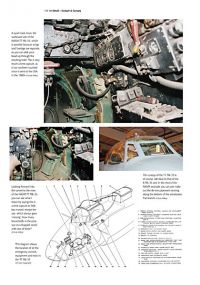Valiant Wings Publishing | The de Havilland Mosquito Part 1: Bomber & Photo-Reconnaissance
Reviewed by Kevin Futter

This latest in the Airframe & Miniature series from Valiant Wings Publishing kicks off a multi-part exposé on de Havilland's famous Mosquito, and is entitled The de Havilland Mosquito Part 1: Bomber & Photo-Reconnaissance. This is a timely publication for LSP modellers, as the Mosquito has received a lot of attention in our scales in recent years, with Airfix, Tamiya, and HK Models all releasing impressive large-scale kits. There's also the ancient Revell kit, which, though now thoroughly outclassed, can still be turned into a fine model with some effort.
The book is divided into two main sections, Airframe Chapters and Miniature Chapters, each of which has a number of sub-sections, accounting for 192 pages in all.
Airframe Chapters
- Evolution - The Bombers
- Evolution - Photo-Reconnaissance
- Other Variants
- Camouflage & Markings
Miniature Chapters
- Mosquito Bomber, PR and Target Tug Kits
- Building a Selection
- Building a Collection
- In Detail
There is also a list of Appendices:
- Mosquito Kit List
- Mosquito Accessory List
- Mosquito Decal List
- Bibliography
The last part of the book features an insert of a set of fold-out plans in 1/48 scale.
The Airframe Section
The Airframe section starts off with a two-chapter summary, each covering the bomber and photo-reconnaissance variants respectively. This is a very handy primer on not only the sequence in which the variants were produced, but the defining differences between them. Each variant is illustrated with a port-side profile, neatly rendered in black, white, and grey.
Chapter 3 is simply titled "Other Variants", but specifically covers target tug and Meteorological Flight aircraft, in the same style as the previous two chapters.
Chapter 4 is "Camouflage & Markings", and is tackled a little differently from previous entries in the series. Rather than a distinct section containing the colour profiles all in one place, they are instead presented in situ, alongside the description or explanation of that particular scheme or markings variation. It doesn't have quite the same visual impact as a series of pages packed with inspiring artwork, but I think it offers more utility for the modeller, and makes a more direct connection between the artwork and the history.
Page 65 features a table of colour references, with each colour cross-referenced with acrylic (Gunze, Lifecolor, Tamiya, and Xtracrylix) and enamel (Humbrol, Revell, White Ensign, and Xtracolor) paint ranges. Some readers may be disappointed that this chart doesn't cover their favourite paint range, but there are so many available these days that it would be impossible to cover them all. This at least gives the modeller a decent starting point, and is a very welcome feature.
Similarly welcome is the page of stencil placement guides in 1/72 scale. These also cover the type and placement of the various national markings, codes, and serial numbers.
The Miniature Section
Chapter 5 kicks off the Miniature section with a look a selection of available Mosquito kits, limited of course to the bomber and photo-reconnaissance variants. The selection is further limited to kits that have been released since 1998, dating back to the author's previous book on the subject. This leaves out the Revell 1/32 kit, which I think is a bit of a shame, since Revell re-released this kit back in 2014, and it's still currently available.
That said, assessments of older kits are available as a downloadable PDF from the Valiant Wings website. This is a nice touch, and addresses the missing content without having a negative impact on either the cost or size of the published book.
Chapter 6, "Building a Selection", is the modelling section of the book, and features a number of kit builds in 1/72, 1/48, 1/32:
- Hasegawa 1/72 Mosquito B Mk IV - Libor Jekl
- Tamiya 1/72 Mosquito B Mk XVI - Libor Jekl
- Airfix 1/48 Mosquito PR Mk XVI - Steve Evans
- HK Models 1/32 Mosquito B Mk IV Series II - Steve Evans
This is a smaller selection of builds than is normally included in this series, and I personally would have liked to have seen someone tackle the old Revell kit. It's still on the market, and at a much cheaper price than its successors, so is likely to be a popular choice with younger modellers, or those on a budget. An instructive build guide would have been useful in that context.
That said, the builds that are included are all done to a very high standard, which is to be expected from the two modellers concerned - both regulars in this publisher's titles.
One of the most interesting sections to me is chapter 7, "Building a Collection". Through a series of isometric 3-D drawings by Wojciech Sankowski, this section illustrates the pertinent features of each revision of the airframe as it evolved through the bomber and photo-reconnaissance series. When combined with the information presented in the first part of the Airframe section, it becomes a simple matter to understand the features present on any particular variant or sub-variant. In fact, this section could easily have been included in the Airframe portion of the book, rather than the Miniature section.
Chapter 8, "In Detail", features a series of close-up photographs and technical drawings to reveal those airframe details so often sought after by modellers. Many of the photographs are of restored airframes, so the usual caveats regarding those apply here, but they're useful nonetheless. The coverage is quite extensive, encompassing 64 pages for this section alone.
Appendices
The appendices take a similar route to the kit evaluation section, in that only a subset of available aftermarket accessories is listed, with the more obscure or out-of-production items dealt with in the aforementioned downloadable PDF. The combination represents a useful reference for products designed to enhance your Mosquito kit, whatever its scale, mark, or manufacturer. A two-page bibliography is also included, which is handy for further research.
Scale Plans
The final component of the book is a set of fold-out scale plans in 1/48 scale. These are printed on a heavy plain stock, and have been drawn by Richard Caruana. The airframes featured are:
- de Havilland Mosquito B Mk IV (Series I)
- de Havilland Mosquito B Mk IV (Series II)
- de Havilland Mosquito B Mk IX
- de Havilland Mosquito B Mk XX
- de Havilland Mosquito B Mk XVI
- de Havilland Mosquito B Mk 34
- de Havilland Mosquito B Mk 35
- de Havilland Mosquito TT Mk 39
Note that most of these variants are covered via small scrap views that elucidate the differences from the base B Mk IV, rather than each having a full set of dedicated plans.
Sample Pages
Below is a set of sample pages kindly provided by Valiant Wings.
Conclusion
While I can't vouch for the accuracy of any of the included content in this title, it does at first glance appear to be exhaustively researched. The production values are first class, and the contents explore the book's stated remit—airframe and miniature—in extensive detail. There is still a persistent problem with typographical errors, which is a problem that appears to be prevalent across the hobby publication industry, and one that seems impervious to substantive improvement.
Minor grammatical niggles aside, this volume is packed with a wealth of information and detail, is lavishly produced, and should serve as a handy one-stop reference for the bomber, photo-reconnaissance, and target tug versions of the Mosquito. Recommended!
We look forward to Part 2, which will cover the fighter and fighter-bomber variants.
Thanks to Valiant Wings Publishing for the review sample.
© Kevin Futter 2016
This review was published on Saturday, July 09 2016; Last modified on Saturday, July 09 2016




